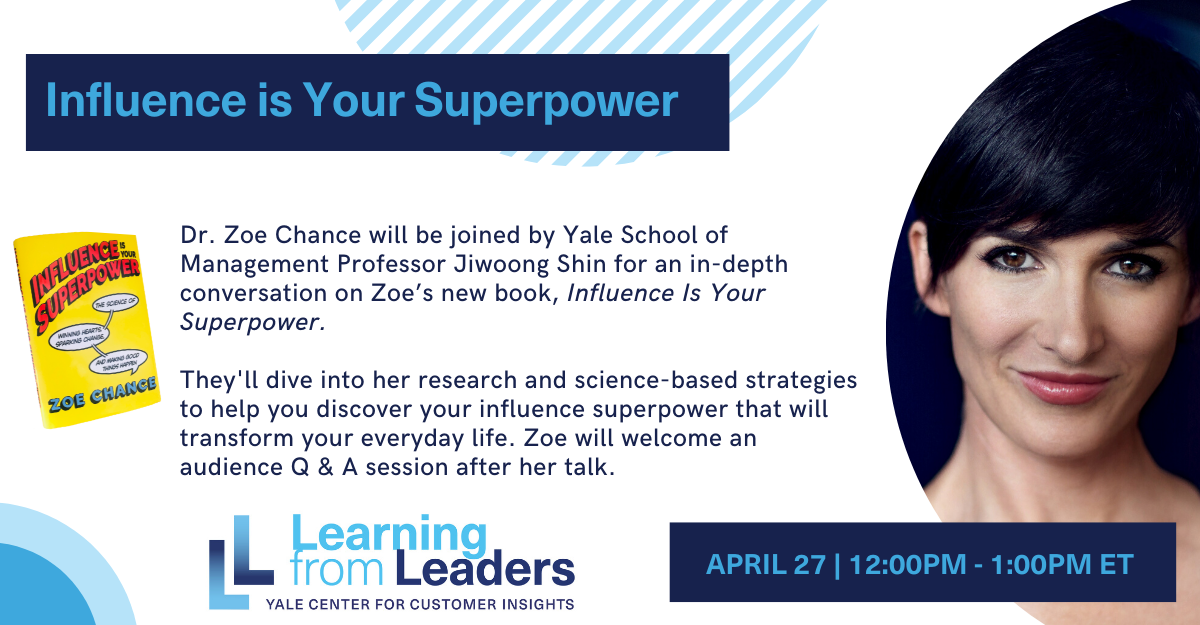
Zoe Chance, SOM’s Marketing Speaker, outlines the basic tools all marketers can leverage to get people to say “yes,” whether it’s influencing internal stakeholders or facilitating the consumer action based on their intentions.
For years, Zoe Luck, a senior lecturer at Yale SOM, has researched and discussed the influence. She researched the subject for her doctorate, examined its subtle flows during her time as a brand manager for Barbie, and ultimately synthesized what she learned into the curriculum of a popular SOM course, “Mastering the influence and persuasion”. This led to the publication of his latest book Influence is your superpower.
During this time, she regularly encountered a key misperception. “A lot of people come to my workshops and classes with the goal of learning how to change mindsets,” she says. But that will rarely happen, especially when the issue under consideration is one that is of deep concern to both parties. “We often end up banging our heads against the wall, and when we focus on that kind of influence, we leave handy fruit rotting on the floor..”
In a recent Learn from leaders conversation with Jiwoong Shin, professor of marketing at SOM, Chance discussed some of the fundamental findings of his work and how marketers should view influence as a way to get people – customers and colleagues – to say yes, then to act according to their intentions. After all, behavior can be changed without changing your mind.
Chance emphasized that effective and influential marketing is not about manipulating the consumer into doing something they don’t want to do, but about helping people do what they already want to do; it’s about mutual and lasting benefits.
Feed the charisma, that people ask frequently Chance about is a way to make it more likely that people will say yes when you ask them. While there are many ways to cultivate a charismatic personality – some people are funny, some quietly engaged, others always distinctly inclusive – constant attention forms the common thread between charismatic individuals.
“The idea of charisma ultimately boils down to this: how much attention do I feel this person is giving me?” says chance. This measure goes hand in hand with traits like empathy and the ability to stay open-minded. “Spoiler alert: to be influential, you have to be influenced.With that in mind, Chance recommended enrolling in improv classes as a powerful tool for teaching people to listen deeply and let go of self-awareness. (the “anti-charisma”,” said Luck).
Influence, however, is not just about getting people to say yes; it requires getting them to act on what they say – that is, closing what Chance calls “the action-intention gap.” She described a nationwide campaign undertaken by the United States Department of Agriculture that spent $50 million a year to try to increase the number of fruits and vegetables eaten daily. In five years, awareness rates on the issue have quadrupled; however, the number of people who actually ate the recommended daily serving of fruits and vegetables remained stable.
“Knowing the importance of eating more healthy foods and having that intention didn’t, at the end, important,” says Chance. “These are the behavioral barriers that needed to be focused on.”
One of the easiest ways to bridge this gap is to make the action you want as easy as possible for people. In the marketing world, this is measured by the customer effort score, and it is more predictive than any other measure of customer loyalty. Chance quoted on survey of nearly 100,000 people who found that a low effort score translates to a 95% likelihood of repurchase, regardless of how much a consumer likes the given product or service.
“It’s not necessarily important that we all use this metric,” Chance says. “The most important thing is to hear the message: if you want to influence people in any context, make the behavior you are looking for as simple as possible.
The most important thing is to hear the message: if you want to influence people in any context, make the behavior you are looking for as easy as possible.
She demonstrated this point with a long-standing collaboration between YCCI and Google, one of many partnerships YCCI has developed with industry leaders. Although the scope of the project with Google has grown over the years, the partnership began by looking for ways to encourage Google employees, who have access to free snacks all day and often gain weight in the first year. , to avoid eating when they are not eating. I do not want. A very effective solution that was found – obvious in hindsight – was to put a greater distance between the drink stations and the snack stations, so that the water refills didn’t encourage a handful of M&Ms. This change alone reduced snacks by 50%. “We were trying to help people make healthier choices without thinking,” says Chance.
Ultimately, Chance noted that “influence is science – not rocket science – and we’re made to do it: it’s how human beings evolved, how we survived as babies , how we survived as a species and thrived across the planet.” Decades of research and practice have helped her establish deep expertise in the tools and strategies that support the quiet work of persuasion.” And now I hope to help other people understand the psychology of influence so they can be more effective and more connected.”

Comments are closed.